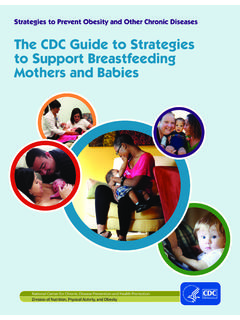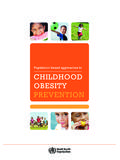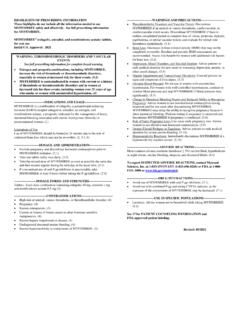Transcription of The Physical Activity Questionnaire for Older Children ...
1 The Physical Activity Questionnaire for Older Children (PAQ-C) and Adolescents (PAQ-A) Manual Kent C. Kowalski, College of Kinesiology University of Saskatchewan Saskatoon, Saskatchewan, Canada Peter R. E. Crocker, School of Human Kinetics University of British Columbia Vancouver, British Columbia, Canada Rachel M. Donen, Bsc. Honours College of Kinesiology University of Saskatchewan Saskatoon, Saskatchewan, Canada August 2004 College of Kinesiology University of Saskatchewan 87 Campus Drive Saskatoon, SK, Canada S7N 5B2 1 TABLE OF CONTENTS CHAPTER 1: 2 Why were the PAQ-C and the PAQ-A Measures Created?..2 Limitations and Strengths of the PAQ 3 4 CHAPTER 2: Physical Activity Questionnaire for Older Children (PAQ-C)..5 What is the PAQ-C?..5 Keys to Successful 5 5 Validation Reliability Studies Concerning the 6 PAQ-C 7 CHAPTER 3: Physical Activity Questionnaire for Adolescents (PAQ-A).
2 11 is the PAQ-A?..11 Keys to Successful 11 11 Validation Reliability Studies Concerning the 12 PAQ-A 12 CHAPTER 4: Overview of Studies Using the Physical Activity 16 How has the PAQ-C and the PAQ-A Been Utilized in Research?.. 16 Complete Reference List .. 32 About the 37 Contact 37 2 CHAPTER 1: INTRODUCTION An important challenge in determining the relationship between health and Physical Activity is valid assessment. Various levels of Physical Activity participation are associated with health benefits and/or health risks. As a result, it is important that we have valid tools for assessing Physical Activity at various ages. This becomes particularly important with longitudinal research, which might span a number of years. The Physical Activity Questionnaire for Older Children (PAQ-C) and the Physical Activity Questionnaire for Adolescents (PAQ-A) provide a general measure of Physical Activity for youth from grades 4-12 (approximately ages 8-20).
3 The purpose of the PAQ manual is to ensure that you can easily administer the PAQ measures in research and to provide you with a library of studies utilizing the PAQ-C and the PAQ-A. Physical Activity Questionnaire for Older Children (PAQ-C) The PAQ-C is appropriate for elementary school-aged Children (grades 4-8; approximately ages 8-14) who are currently in the school system and have recess as a regular part of their school week. Physical Activity Questionnaire for Adolescents (PAQ-A) The PAQ-A is appropriate for high school students (grades 9-12; approximately ages 14-20) who are currently in the school system. This manual provides a comprehensive overview of the PAQ-C and PAQ-A. Chapter 1: Describes why the PAQ-C and the PAQ-A were created and the limitations and strengths of these measures. Chapters 2 and 3: Includes keys to successful administration of the PAQ-C and the PAQ-A, scoring the questionnaires, validation and reliability studies, and the actual measures.
4 Chapter 4: Summarizes the studies that we are aware of (as of August 2004) that have used or reviewed the PAQ-C or PAQ-A. Why were the PAQ-C and the PAQ-A Created? It is difficult to determine the best instruments to assess Physical Activity when a gold standard does not exist. Examples of instruments that have been used include a variety of physiological indicators, laboratory methods, direct observation, motion sensors, and self-report measures (Sallis & Saelens, 2000; Tremblay, Shephard, McKenzie, & Gledhill, 2001; Welk & Wood, 2000). Self-report measures are most frequently utilized for the assessment of Physical Activity levels in Children and adolescents because they are typically low in cost and can be 3easily administered to large populations. However, few recall instruments have strong validity and are feasible for large-scale research (Crocker, Bailey, Faulkner, Kowalski, & McGrath, 1997).
5 In response to the need for a valid and feasible self-report measure for large-scale research with Children and adolescents, the Physical Activity Questionnaire for Older Children (PAQ-C; Crocker, Bailey, Faulkner, Kowalski, & McGrath, 1997; Kowalski, Crocker, & Faulkner, 1997) and the Physical Activity Questionnaire for Adolescents (PAQ-A; Kowalski, Crocker, & Kowalski, 1997) were developed and validated. The PAQ-C and PAQ-A are self-administered, 7-day recall questionnaires that measure general moderate to vigorous Physical Activity levels during the school year. Generally, the PAQs have had relatively strong correlation coefficients with other Physical Activity measures compared to other recall measures (Kowalski, Crocker, & Faulkner, 1997; Kowalski, Crocker, & Kowalski, 1997). The PAQ-C and the PAQ-A may be advantageous for use in longitudinal research.
6 The PAQs low cost, reliable and valid assessment of Physical Activity from childhood through adolescence, and ease of administration make the PAQs feasible for large-scale studies. The questionnaires use a common scoring scheme and were used successfully in the University of Saskatchewan s longitudinal bone mineral accrual study (Bailey, McKay, Mirwald, Crocker, & Faulkner, 1999). The Limitations and Strengths of the PAQ Measures All Physical Activity measures, including the PAQ-C and the PAQ-A, have their strengths and limitations. For example, some tools may or may not be feasible for large-scale research, be cost and time efficient, have good adherence, have participant demand, and/or have acceptable distribution properties. The PAQ-C s and the PAQ-A s limitations 1) The PAQ-C and PAQ-A were developed to assess general levels of Physical Activity .
7 They do not provide an estimate of caloric expenditure or specific frequency, time, and intensity information. 2) The PAQs do not discriminate between specific Activity intensities, such as moderate and vigorous activities; they simply provide a summary Activity score (see the scoring section in Chapters 2 and 3). 3) The PAQ-C and the PAQ-A are only appropriate when used during the school year; they should not be used to assess Physical Activity in the summer or holiday periods. Therefore, the PAQ-C and the PAQ-A only assess activities for individuals in the school system. The PAQ-C s and the PAQ-A s strengths 1) The PAQ-C and the PAQ-A have been supported as valid and reliable measures of general Physical Activity levels from childhood to adolescence (see the validation/reliability studies in Chapters 2 and 3). The PAQs measurement of general Physical Activity levels is one its strengths because it is difficult to precisely measure intensity, frequency, and duration of young people s activities, especially with self-report (Kowalski, Crocker, & Faulkner, 1997) 2) The PAQs utilize memory cues such as lunch and evening items to enhance the recall ability of Children and adolescents (see the PAQ measures in Chapters 2 and 3).
8 3) The PAQ-C and PAQ-A are cost and time efficient, easy to administer to large-scale populations, and display normal distribution properties (see the validation reliability studies in Chapters 2 and 3).. 4 References Bailey, D. A., McKay, H. A., Mirwald, R. L., Crocker, P. R. E., & Faulkner, R. A. (1999). A six-year longitudinal study of the relationship of Physical Activity to bone mineral accrual in growing Children : The University of Saskatchewan bone mineral accrual study. Journal of Bone and Mineral Research, 14, 1672-1679. Crocker, P. R. E., Bailey, D. A., Faulkner, R. A., Kowalski, K. C., & McGrath, R. (1997). Measuring general levels of Physical Activity : Preliminary evidence for the Physical Activity Questionnaire for Older Children . Medicine and Science in Sports and Exercise, 29, 1344-1349. Kowalski, K. C., Crocker, P. R. E.
9 , & Faulkner, R. A. (1997). Validation of the Physical Activity Questionnaire for Older Children . Pediatric Exercise Science, 9, 174-186. Kowalski, K. C., Crocker, P. R. E., & Kowalski, N. P. (1997). Convergent validity of the Physical Activity Questionnaire for Adolescents. Pediatric Exercise Science, 9, 342-352. Sallis, J. F., & Saelens, B. E. (2000). Assessment of Physical Activity by self-report: Status, limitations, and future directions. Research Quarterly for Exercise and Sport, 71, 1-14. Tremblay, M. S., Shephard, R. J., McKenzie, T. L., & Gledhill, N. (2001). Physical Activity assessment options within the context of the Canadian Physical Activity , Fitness, and Lifestyle Appraisal. Canadian Journal of Applied Physiology, 26, 388-407. Welk, G. J. & Wood, K. (2000). Physical Activity assessments in Physical education: A practical review of instruments and their use in the curriculum.
10 Journal of Physical Education, Recreation and Dance, 71, 30-40. 5 CHAPTER 2: Physical Activity Questionnaire for Older Children (PAQ-C) What is the PAQ-C? The PAQ-C is a self-administered, 7-day recall instrument. It was developed to assess general levels of Physical Activity throughout the elementary school year for students in grades 4 to 8 and approximately 8 to 14 years of age. The PAQ-C can be administered in a classroom setting and provides a summary Physical Activity score derived from nine items, each scored on a 5-point scale. Keys to Successful Administration 1) When the PAQ-C is administered it is important to stress 2 points: a) Explain it is NOT A TEST b) Explain you are interested in ACTUAL Activity during the last 7 DAYS 2) To prevent Missing Data, have the research assistants quickly glance through the questionnaires when they are gathered from the students.









